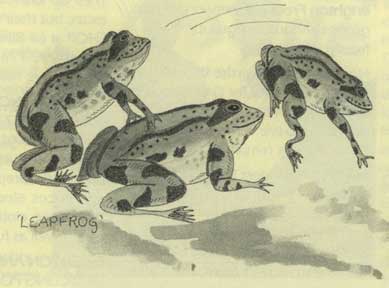Aahhggs and Ooohhs
by Jan Curry from The Round Hill Reporter March 2007
Aahhggs and ooohhs - including frogs and toads

Walking with friends round the garden this time of the year, I usually get a lot of 'ooohhs' - robins, wrens, long tailed tits and a pretty rare sighting of a female blackcap; the tentative early notes of blackbirds soon to be in full song; emerging violets, celandines, snowdrops and primroses; a still sleepy bumble bee and the heady perfume of winter flowering honeysuckles and golden spires of mahonia all just cry out for appreciative 'ooohhs.'
I'm a bit perverse though, I love the ooohhs but can't wait to come across the aahhggs. In fact I've already encountered two - on February 14th, St. Valentine's Day, the day when folklore says the birds choose their mates - I found frogs already in the ponds laying frog spawn and a number of warty, squat toads were lumbering across the grass towards their chosen breeding watery place. Frogs and toads return to the same pond every year - the pond they lived in as tadpoles - often hopping or crawling long distances to do so. In the wild, many ponds are disappearing, drying up or being concreted over, so garden ponds are becoming life savers to these amphibians. They will eat all your slugs and creepy crawlies (as long as you don't put slug pellets down, which will harm them in the same way as we can be harmed when bad things get into our own food chains).
Soon, three more potential languid creatures but in the Spring, they perform crazy acrobatics in the water. They look a bit scary, but not inebriated, so I don't know where the expression (I guess I'd better not repeat it here, as this is a refined magazine) comes from.
And then the dragon fly, a creature that evolved - wait for it - nearly three hundred million years ago. I read, 'they have a top speed of forty miles an hour, they can fly backwards and can hover waiting for their prey to emerge - they are more deadly than any tiger in the jungle.*' 'Aahhgg !' They live in this garden, probably yours too.
Luckily, bats are definitely one of my oohhs but to many they are unfortunately an aahhgg. One pipistrelle can eat around 3,000 insects in a single night. The Level and the Round Hill have more bats than anywhere else in central Brighton. Bats are clean creatures, they do not gnaw wiring, their droppings are disease free and no bat would deliberately become entangled in your hair, as they use their built-in sonar systems to guide them around objects. Come on now, all together oooohhhh not aaahhhggg!
* Chris Packham's "Back Garden Nature Reserve" (one of the best wild life garden books I have read.)
This page was last updated by Ted on 09-Nov-2013
Aahhggs and ooohhs - including frogs and toads

Walking with friends round the garden this time of the year, I usually get a lot of 'ooohhs' - robins, wrens, long tailed tits and a pretty rare sighting of a female blackcap; the tentative early notes of blackbirds soon to be in full song; emerging violets, celandines, snowdrops and primroses; a still sleepy bumble bee and the heady perfume of winter flowering honeysuckles and golden spires of mahonia all just cry out for appreciative 'ooohhs.'
I'm a bit perverse though, I love the ooohhs but can't wait to come across the aahhggs. In fact I've already encountered two - on February 14th, St. Valentine's Day, the day when folklore says the birds choose their mates - I found frogs already in the ponds laying frog spawn and a number of warty, squat toads were lumbering across the grass towards their chosen breeding watery place. Frogs and toads return to the same pond every year - the pond they lived in as tadpoles - often hopping or crawling long distances to do so. In the wild, many ponds are disappearing, drying up or being concreted over, so garden ponds are becoming life savers to these amphibians. They will eat all your slugs and creepy crawlies (as long as you don't put slug pellets down, which will harm them in the same way as we can be harmed when bad things get into our own food chains).
Soon, three more potential languid creatures but in the Spring, they perform crazy acrobatics in the water. They look a bit scary, but not inebriated, so I don't know where the expression (I guess I'd better not repeat it here, as this is a refined magazine) comes from.
And then the dragon fly, a creature that evolved - wait for it - nearly three hundred million years ago. I read, 'they have a top speed of forty miles an hour, they can fly backwards and can hover waiting for their prey to emerge - they are more deadly than any tiger in the jungle.*' 'Aahhgg !' They live in this garden, probably yours too.
Luckily, bats are definitely one of my oohhs but to many they are unfortunately an aahhgg. One pipistrelle can eat around 3,000 insects in a single night. The Level and the Round Hill have more bats than anywhere else in central Brighton. Bats are clean creatures, they do not gnaw wiring, their droppings are disease free and no bat would deliberately become entangled in your hair, as they use their built-in sonar systems to guide them around objects. Come on now, all together oooohhhh not aaahhhggg!
* Chris Packham's "Back Garden Nature Reserve" (one of the best wild life garden books I have read.)